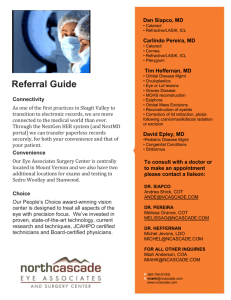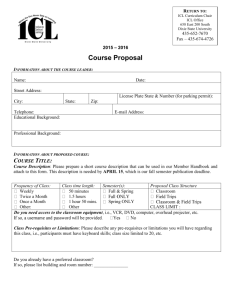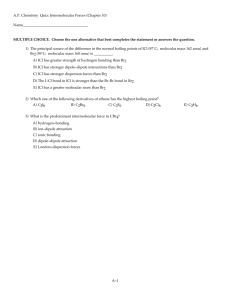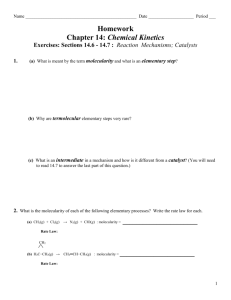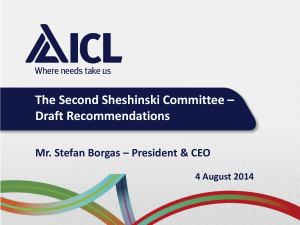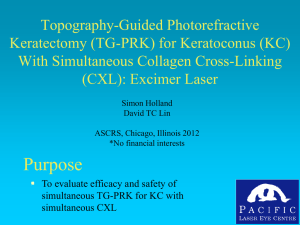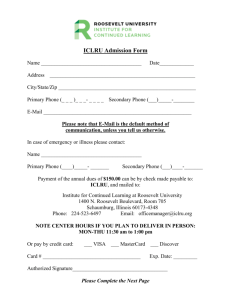STAAR ICL: Asian Eyes
advertisement
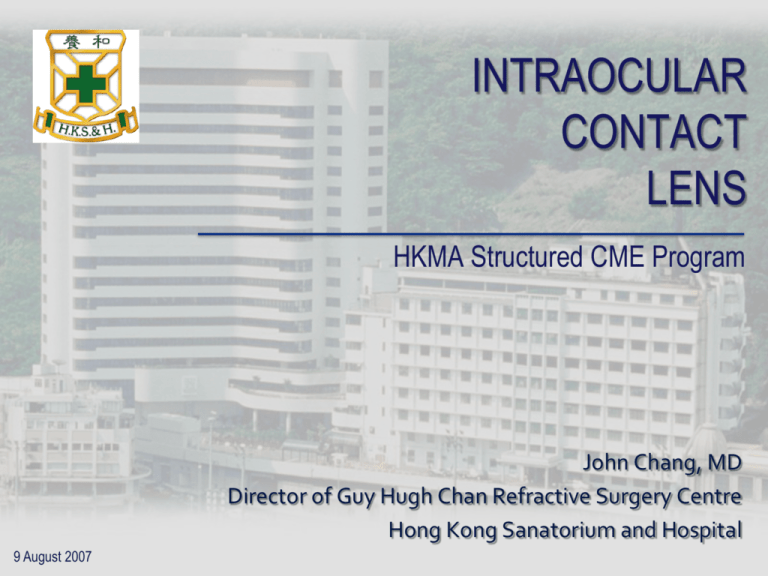
INTRAOCULAR CONTACT LENS HKMA Structured CME Program John Chang, MD Director of Guy Hugh Chan Refractive Surgery Centre Hong Kong Sanatorium and Hospital 9 August 2007 LASIK is not the best option for every patient • Dioptre removal/optical zone & quality of vision trade-off • Large pupils • Dry eyes • Steep / flat corneas • « Funny corneas » / Keratoconus • Thin corneas We all have those patients ! Phakic IOLs Advantages – Preserves Corneal topography. – No induced aberrations – => Better quality of vision – High predictability. – Stable refractive outcome. – Safe in eyes with suspicious corneas. – Removable – Minimal capital expenses. Introduction • Posterior Chamber Sulcus Fixated Lens • Version 4 • Myopia -3.00 D to > -20.00 D • Hyperopia +3.00 D to +17.00 D Loading the ICL • The ICL is marked to ensure proper orientation in the eye as it unfolds Lower left Leading right Alignment Marks Clear Corneal Incision • Temporal, clear corneal incision orients best to iris plane Video - ICL Injection ICL Positioning • Use the paracentisis Video: ICL Positioning • Rotate using the edge of the lens or on the haptic “body” • OK to use footplates 73 Eyes Since 6th May 2002 • Age : 23 to 47 • Mean age : 34.33 ± 6.37 yrs • Male : 12 • Female : 36 Pre-Op MRSE • Range : -7.00 D to -24.75 D • Mean : -14.38 ± 3.45 D Follow up • 1 day, 1 week, 1 month, 3 month, 6 month, and 1 year and beyond • Dilated slit lamp & fundus exam (DFE) for all eyes at 6 months • Range: 2 weeks to 43.8 months • Mean: 15.9 months Predictability of Refraction Planned Refraction • Within ± 0.50 D : 45 (61.6 %) • Within ± 1.00 D : 59 (80.8 %) Post-Op UCVA Those eyes with 20/20 or better Pre-Op BCVA 20/15 19 (48.7 %) 20/20 or better 31 (79.5 %) 20/25 or better 36 (92.3 %) 20/40 or better 39 (100.0 %) Worse than 20/40 0 (0 %) Total 39 Stability of refraction Mean MSE at each follow up 2 -0.23 -0.1 Diopter -2 -0.1 -0.19 -0.3 -0.14 -0.39 -6 mean MSE -10 -14 -14.38 -18 pre-op 1 wk 1m 3m 6m Follow up time 12 m 18 m 24 m Safety Pre- vs Post- BCVA gained 2 or more lines 14 (19.2 %) gained 1 line 39 (53.4 %) no change 18 (24.7 %) lost 1 line 2 (2.7 %) Lost > 1 line 0 (0%) Lost 1 line • Age: 39 M • Pre-op MRSE: -10 D 20/20 • Post-op MRSE: +0.13 D 20/25 • Follow up: 1 month Patient complaint of difficulty with reading and elected to have ICL removed despite near VA J2 after 1 month. Lost 1 line • Age: 39 F • Pre-op MRSE: -13.88 D 20/15 • Post-op MRSE: -0.50 D 20/20 • Follow up: 14.9 months Post-op BCVA varied between follow up visits from 20/15 to 20/20. No other complication was noted. Complications Out of 73 eyes: • 1 (1.4 %) ICL size too small – observe • 1 (1.4 %) brow ache for 2 months • 1 (1.4 %) ICL removed after 1 month ( pt didn’t like it) 39 year old male, c/o near vision problem MRSE at 1 month: +0.13 D • 1 (1.4 %) overcorrect by +1.5 D (VD not at 12mm) Complications • 1 eyes (1.4 %) complained of seeing extra light from P.I. • 17 eyes (23.3 %) developed transient IOP rise within 2 month post op; – range 23 to 30 mmHg; – all controlled by timolol; – all resolved by 1 month; – only 3 eyes in 2006, all other before 2005 Complications • 2 eyes (2.7 %) developed ASC Mean pre-op MSE -9.28 D -11.25 D MSE at last visit -3.00 D 20/20 -1.25 20/20 UCVA 20/150 20/25 ACD 3.2 3.18 WTW 11.5 11 Lens type ICM125V4 ICM115V4 Comment onset at 20 month onset 13 days, visually significant at 18 months Early result: Toric ICL 25 eyes (since June 2004) • • • • Age range: Mean age: M:F Mean follow up: 23 to 44 32.0 ± 6.8 yrs 4 : 14 7.5 ± 4.4 months (range 1.4 to 18.8 months) Early result: Toric ICL Mean ICL power: Sphere Cylinder -18.44 ± 3.22 D +3.68 ± 1.20 D Pre-op Post-op Mean sphere -13.85 ± 3.20 D -0.20 ± 0.51 D Mean cylinder +2.95 ± 1.07 D +0.64 ± 0.47 D Mean MSE -12.36 ± 3.06 D +0.03 ± 0.34 D Early result: Toric ICL Post-op mean MSE at each follow up 4 Diopter 0 0.36 0.21 0.18 0.03 -0.06 -4 mean MSE -8 -12 -12.36 -16 pre-op 1 wk 1m 3m Follow up 6m 12 m Early result: Toric ICL Cumulative post-op BCVA and UCVA 20/20 or better pre-op BCVA 100.00% 80.00% 60.00% Post-op UCVA Post-op BCVA 40.00% 20.00% 0.00% 20/15 20/20 20/25 20/30 20/40 Advantages ICL vs LASIK • No / Minimal night vision problems • Stability /Faster recovery. • Correct much higher ranges of myopia (-3.0 D to -20.0 D) • Also correct hyperopia (+3.0 D to +17.0 D) • Reversible • No ectasia Advantages ICL vs LASIK • 2 patients had ICL in one eye (-19 D, -17 D) and LASIK in the other eye(-14 D, -13 D) • Higher myopia in the eyes with ICL • Both patients report better quality vision with ICL despite the higher myopia • Stability – no initial overcorrection. Advantages ICL vs ACIOL • No endothelial cell loss, no AC reaction • Small self-sealing incision -No/less induced astigmatism • No need to pre-cut flap in bioptics • Can correct astigmatism at the same time -(LRI or Toric ICL) The Verisyse anterior-chamber Lens Picture from www.gutsehen.de/gfx/iol_verisyse.jpg Disadvantages • Clinically significant ASC 1.3%* • Sizing can be difficult, Orbscan not always reliable • Glaucoma? Pigment dispersion? • Expensive • 2 Procedures: Laser P.I. First (uncomfortable), then lens implantation *5 year follow up US FDA MICL Clinical Trial – in press Conclusion • ICL and Toric ICL results very encouraging • Transient IOP rise 2° to Occucoat? • Accuracy as good / better than LASIK for high myopia • Much better immediate and long term stability than Lasik. • Technically not difficult (Avg surgery time 25 mins) • No / Minimal night vision problems • Short learning curve –easier than Phaco What if one develops a cataract extraction leads to immediate presbyopia? Multi-Focal IOL *Diagrams from AMO Refractive IOL - Array *Diagrams from AMO *Diagrams from AMO *Diagrams from AMO *Diagrams from AMO *Diagrams from AMO Adjustment by human eye to Multi-Focal IOL *Diagrams from AMO Basic Theory • Diffractive MIOL - Tecnis MF near focus *Diagrams from AMO far focus *Diagrams from AMO TecnisMF Array ReZoom near focus *Diagrams from AMO far focus Patients No. of patients No. of eyes Mean age Range Array 59 95 54 + 11.9 35 to 85 ReSTOR 27 43 65 + 9.7 50 to 84 TecnisMF 130 179 59 + 13.3 7 to 87 Refraction Array ReSTOR TecnisMF -10.00 -0.60 -6.18 ±7.9 ±3.07 ±5.29 +7.75 to -31.25 +4.00 to -6.75 +5.63 to -18.00 Postop mean MRSE (D) -0.22 -0.26 0.04 STD ±1.01 ±0.68 ±0.57 +2.38 to -6.63 +1.00 to -2.00 +2.00 to -2.25 Preop mean MRSE (D) STD Range Range 3 IOLs Comparison Cumulative Postop UCVA 100 90 Percentage % 80 70 60 Array ReSTOR TecnisMF 50 40 30 20 10 0 20/15 20/20 20/25 20/30 20/40 VA (Snellen) 20/50 <20/60 3 IOLs Comparison Percentage % Cumulative Postop BCVA 100 90 80 70 60 50 40 30 20 10 0 Array ReSTOR TecnisMF 20/15 20/20 20/25 20/30 20/40 20/50 <20/60 VA (Snellen) Safety Preop vs Postop BCVA: Gain / Loss 45 40 Percentage % 35 30 25 Array ReSTOR TecnisMF 20 15 10 5 0 gain > 2 lines gain 2 lines gain 1 line no change loss 1 line Change in BCVA (Snellen) loss >1 line 3 IOLs Comparison 100 Cumulative Postop Near UCVA 90 Percentage % 80 70 60 Array ReSTOR TecnisMF 50 40 30 20 10 0 J1 J2 J3 J5 Near VA J7 >J7 Questionnaire Night glare* Halo* Satisfaction# Array 1.51 (32%) 1.68 (36%) 3.72 (92%) ReSTOR 1.03 (21%) 1.47 (30%) 3.77 (87%) TecnisMF 1.88 (44%) 1.99 (44%) 3.70 (93%) * the higher the score, the more the severity (from 0-5) # the higher the score, the higher the satisfaction (from 0-5) (%) percentage of eyes had score ≥3 TecnisMF Questionnaire % of time spectacles are required 0% <50% >50% Reading 100% 0 0 (including newspaper, books, documents) Near tasks 100% 0 0 (including SMS, watch, etc) Distance 100% 0 0 1 patient requires spectacles for computer Mix and Match- Early result Spectacles dependence Ave. Time Spent Yes No Distance ---- 0% 100% Reading 2.8 hr 0% 100% Computer 5.2 hr 0% 100% All patients are 100% of time SPECTACLES FREE Thank You
